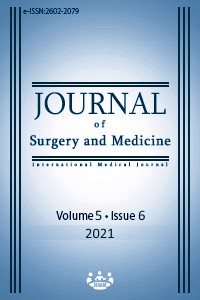Effect of platelet large cell ratio (PLCR) and immature granulocyte (%IG) values on prognosis in surgical site infections
Keywords:
Surgical site infections, Platelet large cell ratio (PLCR), Immature granulocytes (IG)Abstract
Background/Aim: Surgical site infections (SSI) are serious operative complications that occur in approximately 2% of surgical procedures, although rates vary widely according to the type of procedure. Measurement of immature granulocyte percentage (%IG) and Platelet Larger Cell Ratio (PLCR) may be used as a marker of serious bacterial infections. The study aims to evaluate whether the %IG and PLCR are useful additional predictive markers of surgical site infections. Methods: This retrospective cohort study included 50 patients with surgical site infections and 50 control individuals. Patients who were hospitalized in the Istanbul Education and Research Hospital Gynecology and Obstetrics Department between October 2017 and January 2019 were scanned. The Mann-Whitney U test was used to compare continuous variables, and the chi-square test was utilized to compare categorical data. Results: A cut-off of 30.1 for PLRC and 0.35 for %IG had 72% sensitivity and 45% specificity, and 97% sensitivity and 78% specificity (AUC: 0.95), respectively, for the diagnosis of wound site infections. The PLRC and %IG values of the patients with and without wound site infections significantly differed (P=0.052, and P<0.05, respectively). PLRC value slightly negatively correlated with hospitalization duration (r = -0.102), and strongly negative correlated with antibiotic use (r = -0.01). Conclusion: PLCR and %IG can be used as easy, reliable, cost-effective, and fast biomarkers for the detection and evaluation of severity in wound infection.
Downloads
References
Centers for Disease Control and Prevention, National Healthcare Safety Network. CDC/NHSN. Procedure associated Module. Surgical Site Infection (SSI) Event. [Available from: https://www.cdc.gov/nhsn/pdfs/ pscmanual/9pscssicurrent.pdf
Olsen MA, Butler AM, Willers DM, Gross GA, Hamilton BH, Fraser VJ. Attributable costs of surgical site infection and endometritis after low transverse cesarean delivery. Infect Control Hosp Epidemiol. 2010;31(3):276–82.
Hoffbrand AV, Moss PAH, Pettit JE, editors. Essential Haematology. 5th ed. Carlton, Australia: Blackwell publishing Ltd, 2006.
Golebiewska EM, Poole AW. Platelet secretion: From haemostasis to wound healing and beyond. Blood Rev. 2015;29:153–62.
Mancuso ME, Santagostino E. Platelets: much more than bricks in a breached wall. Br J Haematol. 2017;178:209–19.
Hong H, Xiao W, Maitta RW. Steady increment of immature platelet fraction is suppressed by irradiation in single-donor platelet components during storage. PLoS One. 2014;9:e85465.
Thachil J. Platelets in inflammatory disorders: a pathophysiological and clinical perspective. Semin Thromb Hemost. 2015;41:572–81.
Sadik CD, Kim ND, Luster AD. Neutrophils cascading their way to inflammation. Trends Immunol. 2011;32:452–460.
Fernandes B, Hamaguchi Y. Autometed enumeration of Immature granulocytes. Am J Clin. Pathol. 2007;128:454–63.
Ha SO, Park SH., Park SH, Park JS, Huh JW, Lim CM, et al. Fraction of immature granulocytes reflects severity but not mortality in sepsis. Scand J Clin Lab Investig. 2015;75:36–43.
Mare TA, Treacher DF, Shankar-Hari M, Beale R, Lewis SM, Chambers DJ, Brown KA. The diagnostic and prognostic significance of monitoring blood levels of immature neutrophils in patients with systemic inflammation. Crit. Care. 2015;19:57.
Gao Y, Li Y, Yu X, Guo S, Ji X, Sun T, et al. The Impact of Various Platelet Indices as Prognostic Markers of Septic Shock. Plos One. 2014;9(8):e103761.
Zhan Y, Lu R, Meng H, Wang X, Sun X, Hou J. The role of platelets in inflammatory immune responses in generalized aggressive periodontitis. J Clin Periodontol. 2017;44(2):150–7.
Babu E, Basu D. Platelet large cell ratio in the differential diagnosis of abnormal platelet counts. Indian J Pathol Microbiol. 2004;47:202–5.
Van Der GPJ, Mohseni M, Brouwer R, Van Der HB, Steyerberg EW, Groeneveld A. Immature granulocytes predict microbial infection and its adverse sequelae in the intensive care unit. J Crit Care. 2014;29(4):523‐7.
Park BH, Kang YA, Park MS, Jung WJ, Lee SH, Lee SK, et al. Delta neutrophil index as an early marker of disease severity in critically ill patients with sepsis. BMC Infect Dis. 2001;11:299–308.
Simson E, Groner W. The state of the art for the automated WBC differentials. Lab Hematol. 1995;1:13–22.
Briggs C, Kunka S, Fujimoto H, Hamaguchi Y, Davis BH, Machin SJ. Evaluation of immature granulocyte counts by the XE-IG master: upgraded software for the XE2100 automated hematology analyzer. Lab Hematol. 2009;9:117–24.
Nigro KG, O’Riordan M, Molloy EJ, Walsh MC, Sandhaus LM. Performance of an automated immature granulocyte count as a predictor of neonatal sepsis. Am J Clin Pathol. 2005;123:618–24.
Senthilnayagam B, Kumar T, Sukumaran J, Jeya M, Rao KR. Automated measurement of immature granulocytes: performance characteristics and utility in routine clinical practise. Pathol Res Internat. 2012;2:483–9.
Park SH, Ha SO, Cho YU, Park CJ, Jang S, Hong SB. Immature Platelet Fraction in Septic Patients: Clinical Relevance of Immature Platelet Fraction is Limited to the Sensitive and Accurate Discrimination of Septic Patients From Non-Septic Patients, Not to the Discrimination of Sepsis Severity. Ann Lab Med. 2016;36:1-8.
Singer M, Deutschman CS, Seymour CW, Shankar-Hari M, Annane D, Bauer M, et al. The third international consensus definitions for sepsis and septic shock (sepsis‐3). JAMA. 2016;315(8):801‐10.
Naffaa M, Makhoul BF, Tobia A, Kaplan M, Aronson D, Azzam SZ, et al. Procalcitonin and interleukin 6 for predicting blood culture positivity in sepsis. Am J Emerg Med. 2014;32(5):448‐51
Nierhaus A, Klatte S, Linssen J, Eismann NM, Wichmann D, Hedge J, et al. Revisiting the white blood cell count: immature granulocytes count as a diagnostic marker to discriminate between SIRS and sepsis – a prospective, observational study. BMC Immunol. 2013;14(1):1‐8.
Lee CH, Kim J, Park Y, Kim Y, Yoon KJ, Uh Y, et al. Delta neutrophil index discriminates true bacteremia from blood culture contamination. Clin Chim Acta. 2014;427:11‐4.
Ali Ansari-Lari M, Kickler TS, Borowitz MJ. Immature granulocyte measurement using the Sysmex XE-2100. Am J Clin Pathol. 2003;120:795–9.
Pavare, J, Grope, I, Gardovska, D. Assessment of Immature Granulocytes Percentage to Predict Severe Bacterial Infection in Latvian Children: An Analysis of Secondary Data. Medicina (Kaunas, Lithuania). 2018; 54(4):56.
Downloads
- 225 387
Published
Issue
Section
How to Cite
License
Copyright (c) 2021 Berna Şermin Kılıç, Nil Atakul
This work is licensed under a Creative Commons Attribution-NonCommercial-NoDerivatives 4.0 International License.
















